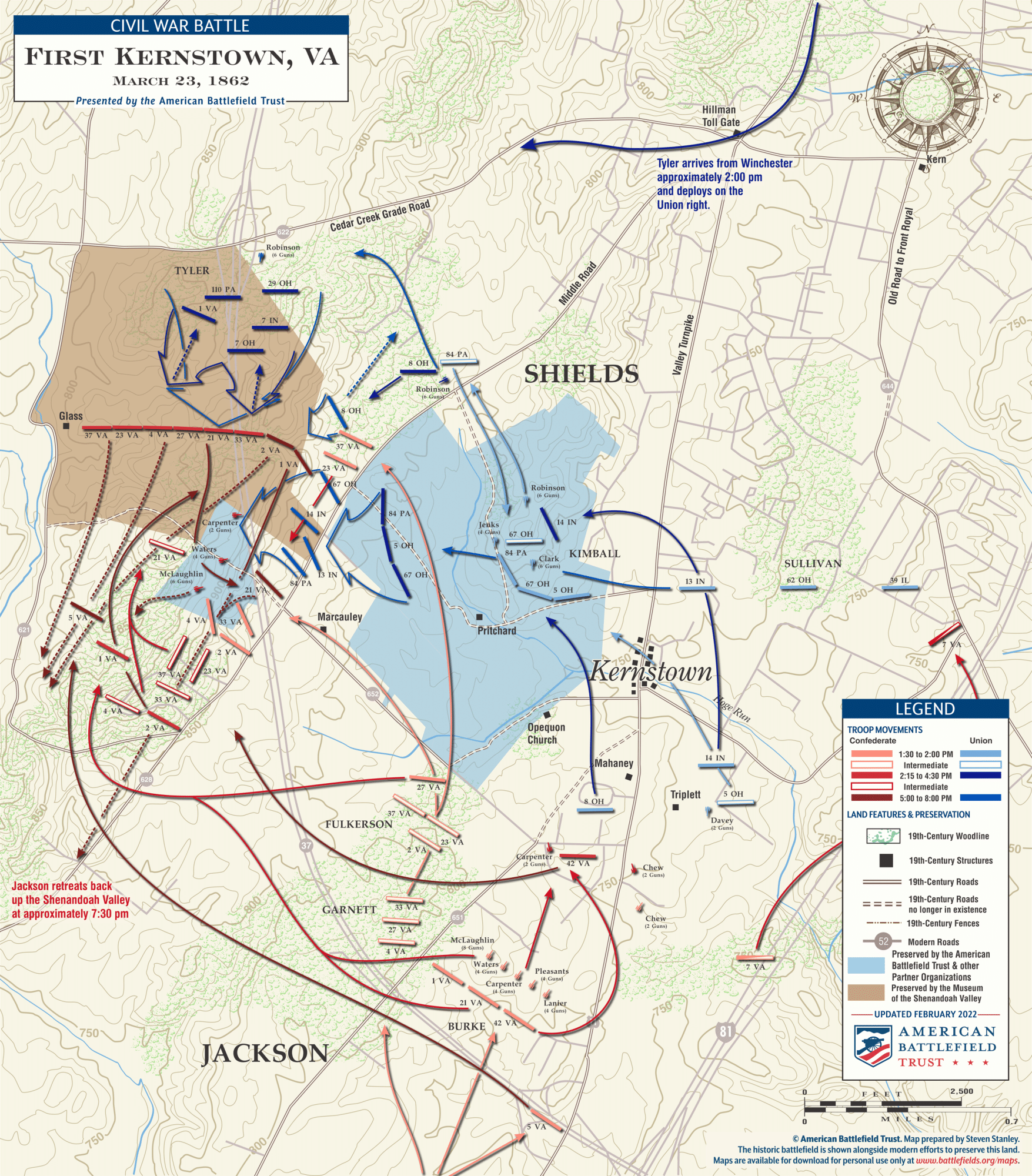Stonewall Jackson’ Valley Campaign
For a period of five weeks in the Spring of 1862, a relatively small and very mobile Confederate army under the command of Thomas “Stonewall” Jackson fought and evaded Union forces throughout the Shenandoah Valley. In this short amount of time Jackson not only disrupted the plans of Lincoln and McClellan, but renewed the Confederacy’s will to fight and made himself internationally famous. During the battles of Kernstown (first), Front Royal, Winchester, and Port Republic, this deeply pious man proved himself to be one of the South’s greatest generals.
Major General Thomas Jackson’s directive was clear. He was to prevent the Union forces in the Shenandoah Valley from leaving to support General George McClellan’s march to Richmond. However, Jackson’s orders were to provide another benefit and that was to raise morale in the Confederacy which had so recently suffered several setbacks, especially in the western theater. In February of 1862, McClellan ordered Major General Nathaniel Banks and his substantial army to enter the valley and to stop Confederate raids on railroads and canals. Jackson had his headquarters in Winchester, Virginia, but retreated when Banks arrived.
After a brief interval, some of Banks’ men were sent east, his army was split, and Jackson took the offensive. 8,500 Union soldiers under Brig. Gen. James Shields defended Winchester. Confederate cavalry under Colonel Turner Ashby clashed with Shields and the Union Brigadier General was wounded on March 22nd, 1862. The command fell to Col. Nathan Kimball who established a defensive position at a place called Kernstown. This is when Jackson attacked with his force of 3,800 with Ashby on his right and two infantry brigades (including the Stonewall Brigade) on his left. Kimball led a counterattack but Stonewall’s forces fought hard. Only after they began to run out of ammunition did the Confederates begin to retreat. The result was a narrow Union victory when superior numbers and position should have made it an easy victory. It had become clear that Jackson was a formidable adversary, so Lincoln ordered more troops into the valley.
Stonewall enjoyed a victory at McDowell, Virginia, then set his sights on Banks’ eastern flank at Front Royal where a 1,000 Union soldiers defended lines of supplies and communications. On May 23rd Jackson attacked Front Royal which was being defended by the 1st Maryland Infantry. Jackson had his own Maryland infantry unit lead the charge. Intense fighting ensued, but Jackson’s superior numbers and training won the day. Roughly 200 Union troops were killed and 700 were captured. Jackson had now broken a link in Banks’ armor.
Stonewall’s ranks had swollen to about 16,000 soldiers by the time Banks had left his command in Strasburg to establish a defensive line back in Winchester. Because of the damage the Confederates had inflicted on his supply lines and because of the rapid march to Winchester, Banks’ army was tired and hungry. Early in the morning on May 25th, Jackson arrayed his lines and descended on the Union position, at first slowly but then unleashing his superior numbers. The Union lines broke and they retreated through the town of Winchester where they were fired upon by locals. What was left of Banks’ army crossed the Potomac and entered Maryland. Jackson had delivered a serious blow.
On June 9th, the Shenandoah Valley Campaign concluded at the Battle of Port Republic. The day before, the Confederates had defeated Union General Fremont at Cross Keys. Jackson planned to reach Port Republic and defeat General Shields with superior forces, but the crossing from Cross Keys to Port Republic proved difficult. Thus when the fighting began, Jackson was actually outnumbered since much of his army was still catching up. The Union occupied a long defensive line including an important hill known locally as “The Coaling.” Jackson knew this hill was crucial to victory and so he sent his forces at it, but they were repulsed. On the second attempt, however, they were able to take “The Coaling” and victory was soon their’s.
Jackson’s Valley Campaign began with a defeat, but ended with a great series of victories. Jackson could now leave the valley and support General Lee in his fight with the Union farther east. Jackson would prove to be one of the most important leaders of the Confederacy and the second greatest commander after Lee. Jackson died before the war’s end, less than a year after his stunning victories in Shenandoah, due to complications from pneumonia after being mistakenly shot by his own troops. Jackson’s personal allegiances are unsavory to the modern scholar, but his accomplishments on the battlefield are unquestionably impressive.
Works Cited
“The Battle of Front Royal — Shenandoah Valley Battlefields National Historic District.” Shenandoah Valley Battlefields Foundation, https://www.shenandoahatwar.org/battle-of-front-royal. Accessed 15 November 2022.
“The Battle of Port Republic — Shenandoah Valley Battlefields National Historic District.” Shenandoah Valley Battlefields Foundation, https://www.shenandoahatwar.org/battle-of-port-republic. Accessed 15 November 2022.
“First Battle of Winchester - Cedar Creek & Belle Grove National Historical Park (U.S.” National Park Service, 22 August 2020, https://www.nps.gov/cebe/learn/historyculture/first-battle-of-winchester.htm. Accessed 15 November 2022.
“Kernstown Battle Facts and Summary.” American Battlefield Trust, https://www.battlefields.org/learn/civil-war/battles/kernstown. Accessed 15 November 2022.
“Stonewall Jackson and the Shenandoah Valley Campaign of 1862 | National Portrait Gallery.” National Portrait Gallery, https://npg.si.edu/blog/stonewall-jackson-and-shenandoah-valley-campaign-1862. Accessed 15 November 2022.











